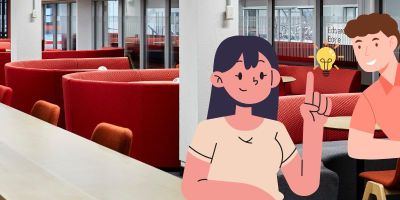Health Sciences Library refurbishment begins

Refurbishment will create a new collaborative learning space in the Worsley Building.
Work is beginning on a new collaborative group space in the Health Sciences Library. The refurbishment project will transform the existing group work area into a vibrant, inclusive space, which champions wellbeing and encourages collaborative learning.
The project is expected to be ready in Spring 2025 and is part of a wider programme of developing University learning spaces.
There will be no group study facilities in the Health Sciences Library during that time. Alternative collaborative and groupwork spaces are available in the other libraries on campus: Edward Boyle, Laidlaw and Brotherton Library.
Co-designed to connect with nature
The project team consulted extensively with students and staff to understand user needs and preferences for the functionality and feel of the new space.
The new collaborative learning space will feel modern and different to other spaces on campus. There will be a connection to nature and wellbeing that will support different types of collaborative and group work.
Power and connectivity
There will be power to charge devices throughout the space. A collaborative IT suite will allow students to bring their own devices and plug into a workstation.
Natural and adaptable lighting
There is currently no natural light in the space and no way for users to adapt the light levels for their needs. The proposed lighting has a combination of dimmable and user-controlled task lighting. A new skylight will be installed in the roof allowing natural light to flood into the space.
Controlled noise
During our consultation period, students told us that noise levels in the existing space can become too loud when the space is full. Acoustic baffling will be installed to reduce the ambient noise. Although the space is not intended to be a silent or quiet space, the sound should be a lot more controlled.
Inclusivity in mind
The new space is designed with inclusivity in mind. There will be new access to the mezzanine area for wheelchair users and the design incorporates best practice for neurodiversity.
Connected to nature
Deeper colours, natural materials and a subtle blend of textures will strengthen the connection to nature. The colour scheme will draw from the colours in the existing wall mural. Plants will also be introduced into the space to enhance the biophilic design.

Artist's impression of the potential layout of the new collaboration space, including additional concepts for furniture
Furniture choice with sustainability
Furniture will create a balance between active collaborative group spaces and space for reflection. There will be a variety of formal and informal furniture for different sized groups, and the large open space will use dividers to create areas for semi-private study.
Most of the furniture in the space will be new, but the project will actively seek out existing furniture that can be refurbished and reused as part of the circular economy. Carpets and soft furnishings will use recycled materials.
The bold design will transform this corner of the Library into a light, open, and engaging space, that will help to foster collaboration, creativity, and academic success.
Michael Fake, the Libraries’ Associate Director: Student Learning and Experience, said, “We are thrilled to be working on this exciting refurbishment of the Health Science Library's group study area. The bold design will transform this corner of the Library into a light, open, and engaging space, that will help to foster collaboration, creativity, and academic success. It reflects our commitment to providing students with the best possible environment for active learning and group study, within a welcoming, comfortable and inspiring atmosphere.”
Realising our vision
This project supports the Libraries’ strategic vision for 2030 to create sustainable and enriched environments for our users.
In particular, to modernise the Health Sciences Library to provide an enhanced and inclusive experience that supports students’ changing needs (strategic priority 12) and to embed environmental and operational sustainability and incorporate nature-inspired thinking in our physical environments. (strategic priority 11)
The extensive collaboration with students and staff is motivated by our desire to adopt user experience approaches to co-produce our physical and digital services with our users (strategic priority 17).
Project updates will be available here at Library news and on the Estates and Facilities project page.




